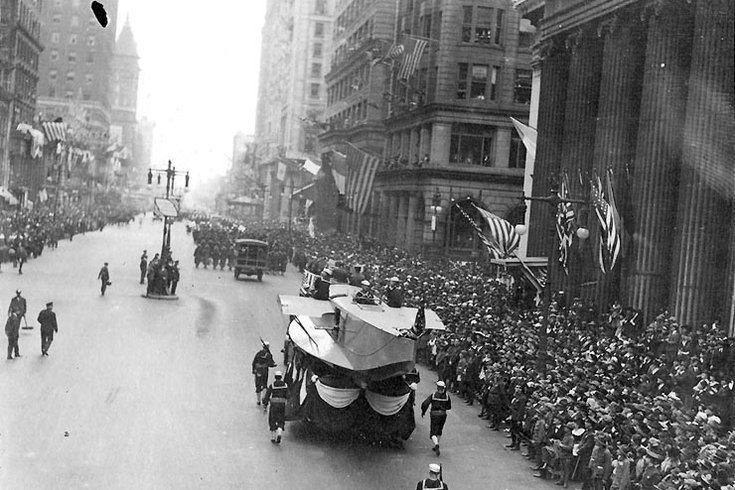
September 23, 2019
 U.S. Naval Historical Center/PROVIDED PHOTO
U.S. Naval Historical Center/PROVIDED PHOTO
A Liberty Loan parade and rally to raise money for World War I down Broad Street on Sept. 28, 1918 helped spread flu from sailors to the general population of Philadelphia.
Some 200,000 people flooded the streets of Philadelphia on Sept. 28, 1918.
World War I was nearing its conclusion, but financing efforts still weighed heavy on the public conscience. So the latest Liberty Loan parade – a patriotic fundraiser featuring military members, veterans and others – went on as planned.
It proceeded despite the looming threat of influenza, which already had devastated many New England communities and had recently begun spreading in Philadelphia.
Within days of the parade, so many people had fallen ill with "Spanish flu" that officials effectively shuttered the city. Six weeks later, some 12,000 people had died. Another 8,000 would succumb in the months to come.
Bodies literally piled up so quickly that many of the victims failed to receive a traditional burial. Some were buried in mass graves. To this day, no memorial exists.
The "Spit Spreads Death" parade aims to finally pay tribute to the people who perished – from Benjamin King, a 23-year-old soldier from East Kensington, to Sadie Younelli, a 4-year-old girl from Point Breeze.
To do so, some 500 people are expected to march up Broad Street from Marconi Plaza in South Philly to City Hall, replicating the original Liberty Loan parade route. The event will kick off Saturday at 5 p.m.
Each participant will march in honor of one of the 751 people who died on Oct. 12, 1918 – the flu's deadliest day. The victims' names each will be called out during the parade. A participant then will pause to hold up a card with the victim's name and allow two illuminated parade floats to pass by.
The event is organized by Blast Theory, an artist group from the United Kingdom. It will feature choral music written by Oscar-nominated composer David Lang and sung by The Crossing, a Grammy-award winning choir from Philly.
Afterward, Blast Theory will create a 15-to-25 minute art film of the parade to be featured in the upcoming Mütter Museum exhibit, "Spit Spreads Death: The Influenza Pandemic in Philadelphia."
"We're inviting everyone to join this unique parade to remember what happened then and to celebrate everyone in public health who keeps us safe today," Blast Theory co-founder Matt Adams said in a statement.
The public can participate for free by registering online. When registering, each participant can select a flu victim to represent.
The Mütter Museum exhibit opens on Oct. 17. It will tell the stories of various flu victims by featuring an assortment of digital interactives, artifacts, photographs and historical documents.
"Spanish flu" killed at least 50 million people across the world between 1918 and 1919, the worst flu pandemic.
At the time, doctors instructed patients to rest in bed, eat well, get fresh air and use Dover’s powder – a pain reliever no longer in use. To guard against infection, a mild antiseptic was recommended to keep the mouth and nose clean.
Unlike most influenza viruses, which normally only impact the nose and throat, the 1918 virus also attacked the lungs. That made viral and bacterial pneumonias common and, in turn, increased the death toll.
Last week, the Centers for Disease Control and Prevention released its vaccination recommendations for the 2019-20 flu season.